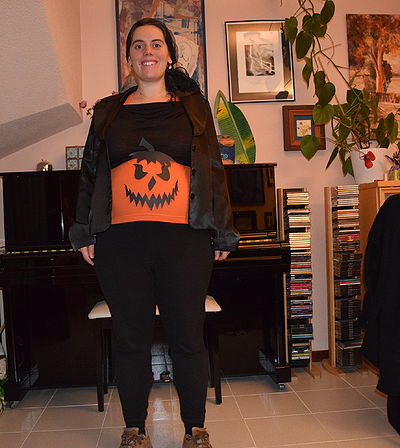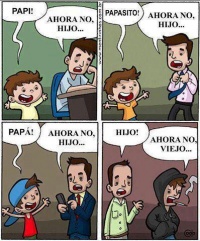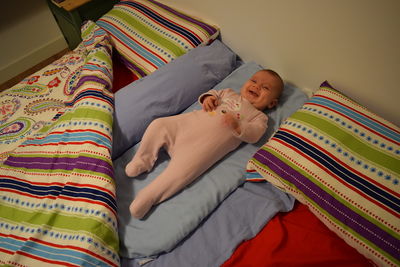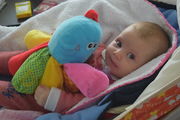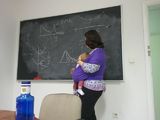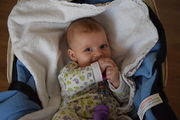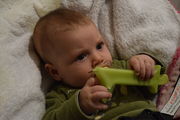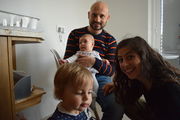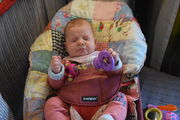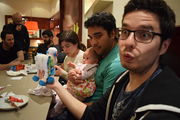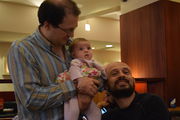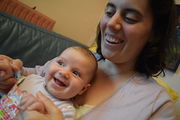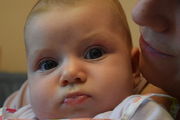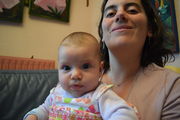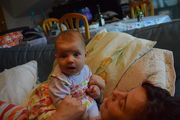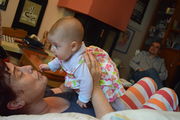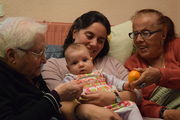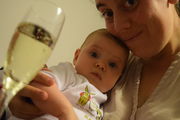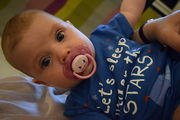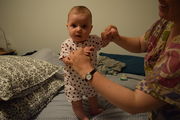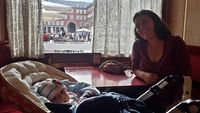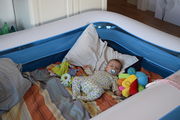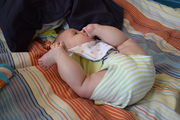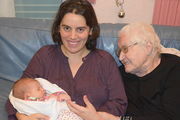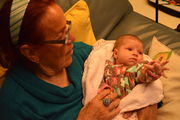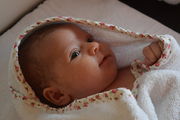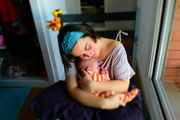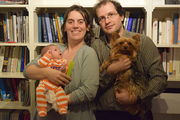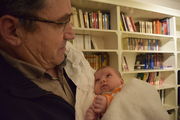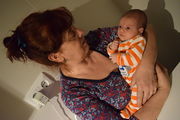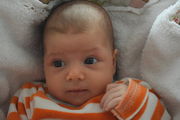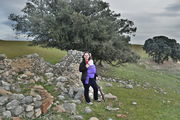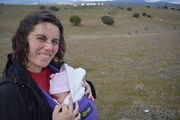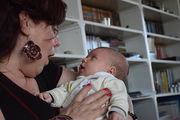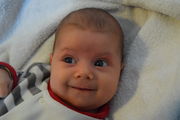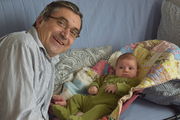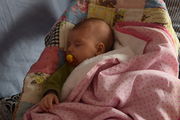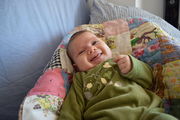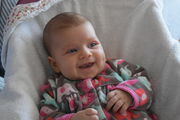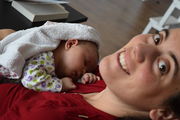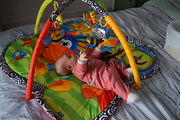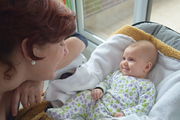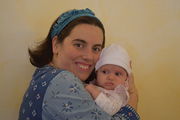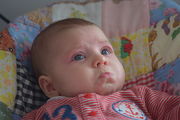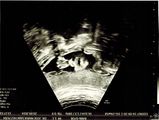m (→Second trimester) |
m (→Second trimester) |
||
| Line 160: | Line 160: | ||
File:Julia-4-meses-DSC_0274.JPG|Su piscina-parque para jugar... | File:Julia-4-meses-DSC_0274.JPG|Su piscina-parque para jugar... | ||
File:Julia-4-meses-DSC_0258.JPG|y echar la siesta. | File:Julia-4-meses-DSC_0258.JPG|y echar la siesta. | ||
| + | File:Julia-4-meses-chupa-pies.JPG|Al principio del cuarto mes Julia descubrió sus pies, que pronto pudo chupar! | ||
</gallery> | </gallery> | ||
Revision as of 15:22, 28 May 2015
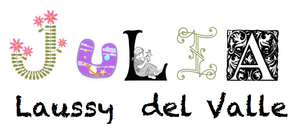
Julia (3 January (2015)) is our daughter, first and, so far, only child.
Contents |
Raising Julia
Attachment parenting
Attachment parenting means to follow your instincts in parenthood which, in general, translates into being there for the baby when she needs it. That is, to pick her up when she cries, to breastfeed her on demand, to have her always nearby, to carry her around as much as possible (using baby wraps or a baby carrier), co-sleeping... As a result, the baby feels secure and nurtured enough ("secure attachment") to develop independence and self-confidence when ready. But above all, this is the most enjoyable way of raising your baby.
Some interesting sites:
- http://www.attachmentparenting.org
- http://www.crianzaautorregulada.com/articulos/por-que-elijo-la-crianza-con-apego
The leading proponents of attachment parenting are William and Martha Sears. In Spain, the best advocate of "crianza con apego" is Dr. Carlos Gonzalez. He has written a few beautiful and fun books on the subject: Bésame mucho: Cómo criar a tus hijos con amor, Un regalo para toda la vida: Guía de la lactancia materna, Creciendo Juntos etc. Some interesting videos from him are: El sueño en bebés. He says things like:
- La infancia es fugaz. Que nuestra obsesión por corregirla no nos impida disfrutarla.
- Yo no dejaría jamás llorar a mi hijo. Ni a mi esposa, ni a mis padres ni a mis amigos. Cuando una persona a la que quiero llora, voy a ver qué le pasa e intento consolarla.
- Malcriar significa criar mal, con poco cariño, sin cubrir las necesidades básicas del niño.
La crianza con apego suele despertar muchas críticas pero todas son bastante rebatibles...
Co-sleeping
It is a sensible and practical thing to do, as many people put it, although there are also studies and interesting books to read on the subject. The most famous one is Sleeping with your baby by James J. McKenna.
Quite naturally, we have been drifting towards co-sleeping with Julia, not only room but also bed sharing.
For her first month, Julia would sleep in our baby stroller cradle, which in our case is removable. We started by placing it on the floor, next to my side of the bed, in order to see her from above during her sleep. Soon enough Fabrice suggested to plug her onto our (large, 160cm-) bed, between us, and that worked even better since I could help her to sleep quite easily without getting up. Just stroking her head or putting back her fallen-out pacifier. Still, after a couple of weeks, it felt like that extra barrier was not needed and things could be made even easier. Even being so physically close to us, Julia would wake up the moment she was placed in the cradle if not deeply asleep. This was annoying... Specially at 3am after gently and quite successfully breastfeeding her to sleep. Furthermore, the fact that we had a trip to France soon ahead of us made me wish we did not need the cradle (we have a rather small car).
By the second month we decided to remove it completely. We placed Julia on the bed, between us, on her little mattress (in order to give us a sense of the room she was taking) and barricaded by Fabrice's side with a pillow. They say that breastfeeding mothers are really tuned to their babies and would never roll onto them, also tend to synchronise their sleep patterns. I quickly realised that this was completely true and I sleep happily in close proximity without any fear. However, for fathers, things are not as natural. They typically fall into a much deeper sleep and need time to develop the instinct to keep the baby safe. This is why we have this pillow, that is covered by a sheet so that it is fixed and there is no risk of falling on top of Julia.
We also follow all the usual recommendations not to have extra pillows or toys or blankets in bed, not to leave any space where she could fall into and not take drugs or alcohol.
It feels completely natural. It also facilitates breastfeeding since it allows me and Julia to barely wake up and go back to sleep without any problem most of the nights. When she does wakes up, I know it instantly and can react quickly to her demands so that she is never fully awake, does not get to the point of crying and does not choke. Cry-less nights! Already interesting. But cosleeping goes further than just these convenient and practical reasons. I love to sleep so close to this beautiful baby, wake up in the mornings to her joyful smile. If she is a bit excited at bed time, I simply caress her and hold her hands for a little while and she quietly and smoothly falls asleep. It feels right and both Fabrice and me, enjoy it immensely.
Baby-led weaning
http://www.babyledweaning.com defines it as "letting your child feed themselves from the very start of weaning... You just hand them the food in a suitably-sized piece and if they like it they eat it and if they don’t they won’t.... No purees, no ice cube trays, no food processor, no potato masher, no baby rice, no weird fruit and veg combos… just you and your child, eating food that you enjoy with you and your family."
This is something we are planning to do when Julia is six months approximately. That is, when she can sit up and grab things and bring them to her mouth (reach for food alone). We would like to do time lapses recording her eating a couple of times a week to see the evolution through the months. Something like these people but for longer.
Some tips from the web and book:
- Forget ‘baby food’. Food’s food, as long as you’re not adding salt. To start off with, think chip-sized because it’s an easy shape for little 6-month-olds to grip, but you’ll soon move on to smaller pieces as it’s more interesting for a child developing a pincer grip.
- As a first food most people steam carrots (to about the degree that they can be smushed ‘twixt your thumb and finger), cut up cucumbers, make toast fingers or crinkle cut bits of mango, that sort of thing, but remember if there’s no reason whatsoever why your baby can’t have a pile of Spaghetti Bolognese or mashed potato to dig into if that’s what the rest of the family is having.
- No bowls, they’re just asking to be flung heavenwards. Put the food on the highchair tray or table and remember, it’s all a learning experience for the baby at this point. They really don’t care whether the experience is ‘oooooh, mango is in my mouth’ or ‘ooooooh, a bowl is flying across the room’.
- An easy-to-clean highchair is a must. If you are weaning in summer don’t be afraid to eat outside or semi-naked and for winter Ikea and Tommee Tippee make great cover-all and pelican bibs. Putting a wipe-clean tablecloth under the highchair is a good idea if you have carpets and some people find that a crinkle cutter is handy to make food extra-grippable.
- Give them what you’re having. If they hate it, fine, they’re getting their calories from milk anyway.
- Don’t put too much on the highchair tray at the one time, just a couple of pieces of food will stop them feeling overwhelmed.
- Timing ‘meals’ to between milk feeds seems to be best, and because it’s just finger food you aren’t limited to staying in. There’s no reason why you can’t pack a wee Tupperware with some carrot or cucumber, buy a banana when you’re out or just pull some bits out of an undressed salad.
- Never put food into a child’s mouth, let them put it in by themselves so that they can control it as it moves backwards. If the baby gags, remember that it’s their way of moving food around in the mouth and don’t panic. Some parents have found that making exaggerated chewing faces and noises reminds the child to get back on track.
Other interesting links:
- article Baby knows best? The impact of weaning style on food preferences and body mass index in early childhood.
Carlos González
Este pediatra es muy entretenido de escuhar sobre el tema: La alimentacion libre de papillas (TED), Alimentacion infantil. Aquí van algunos de sus consejos recogidos en su libro sobre el tema "Mi niño no me come":
Las recomendaciones principales de la OMS y UNICEF:
- Dar EXCLUSIVAMENTE leche materna hasta los 6 meses, a partir de entonces ofrecer otros alimentos complementarios
- Seguir dando el pecho, junto con otros alimentos, hasta los 2 años o más.
- Dar alimentos variados.
- Hasta los 12 meses, dar el pecho ANTES de los otros alimentos.
- Los menores de 3 años deberían comer 5-6 veces al día (al menos).
- Dar preferencia a alimentos ricos en calorías, en hierro y vitamina A. Si es preciso, añadir un poco de aceite de oliva a las verduras, para que tengan más calorías.
Más consejos de Carlos González:
- No obligar NUNCA a comer a un niño
- Al principio no dar muchos alimentos nuevos juntos y empezar con pequeñas cantidades.
- Dar el gluten (trigo, avena, centeno o cebada) con precaución.
- Escurrir los alimentos, no llenarle la barriga con el agua de cocción.
- No corre prisa introducir los alimentos que suelen dar alergia (leche de vaca y derivados, huevos, pescado, soja, cacahuetes), sobre todo si hay antecedentes en la familia.
- No añadir azúcar o sal a lo alimentos.
- No importa por qué alimentos empezar aunque es deseable que sean ricos en hierro: pollo o carne.
- No tomar la fruta separada de otros alimentos sino, como nosotros, de postre. Así la vitamina C de la fruta ayuda a que se absorba el hierro de las verduras, legumbres y cereales.
- No hace falta triturar los alimentos.
- La fruta es muy sana pero los zumos no.... El problema es que en un vaso de zumo caben 2 o 3 naranjas... A los niños pequeños se les llena el estómago de zumo y luego no comen otras cosas... A cualquier edad el exceso de azúcar natural de la fruta puede producir diarrea crónica. La Academia Americana de Pediatría recomienda no dar nunca zumos antes de los 6 meses. Entre el año y los 6 años, el consumo máximo diario es de medio a un vaso no muy lleno y entre los 7 y 18 años, el doble.
- El llamado corte de digestión no existe. No pasa absolutamente nada por mojarse después de comer. Puede usted bañar a su hijo inmediatamente después de comer.
Una conducta alimentaria sana se guía por claves internas (hambre y saciedad), y no por claves externas (presiones, promesas, castigos, publicidad...). los expertos creen que muchos problemas de la adolescencia y la vida adulta, como el hacer dieta de forma obsesiva o el comer compulsivamente, provienen de haber aprendido en la primera infancia, a comer según claves externas. Hágale a su hijo un regalo para toda la vida: permita que aprenda a comer según sus propias necesidades y no según una tabla de calorías.
Otros links interesantes:
- folleto y guía traducidos al castellano de la web Una maternidad diferente.
- Calendario de alimentación infantil.
Growing up with several languages
Playful parenting
PET parenting, Playful parenting
Education and creativity
"The best teachers are those who show you where to look, but don't tell you what to see". Alexandra K. Trenfor
- La educación prohibida: Una película sobre la educación centrada en el amor, el respeto, la libertad y el aprendizaje. ("¿Pero no quieres tener un título, ser alguien en la vida? Yo ya soy alguien en la vida!")
- Born to learn is a fun, thought-provoking series of animations that illustrate ground-breaking new discoveries about how humans learn. Also Responsible Subversive, a social network for people who want to connect and discuss how to change the world by changing the way we raise our children.
- ¿Te atreves a soñar? by inKNOWation España.
- Changing Education Paradigms, by Ken Robinson RSAnimated
- Where good ideas come from?, by Steven Johnson, RSAnimated
- Drive: The surprising truth about what motivates us, by Dan Pink, RSAnimated
- The Empathic Civilisation (by Jeremy Rifkin, RSAnimated)
- What if money was no object? by Alan Watts
- File:On the Psychology of Scientific Creativity--Migdal.pdf by A. B. Migdal (L. D. Landau Institute of Theoretical Physics, Moscow), Contemporary Physics, 20, 121 (1979).
Pictures
Second trimester
First trimester
Dinrid llorando un poquito a papá, pero muy guapa en el vestido que le regaló Juan Pablo.
Intrauterine
First costume of Julia for Halloween 2014:
